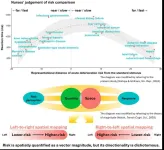Speed of risk perception is connected to how information is arranged
Insights into human perception might prove vital for clinical environments
2025-02-01
(Press-News.org)
Tokyo, Japan – Researchers from Tokyo Metropolitan University have studied how nurses perceive words showing high and low risk ailments. They looked for directional bias, e.g. whether words denoting lower (higher) risk led to a quicker response when placed on the left (right) side or vice versa. They found faster response for significantly higher or lower risk, but different people had different directional biases. Their findings might inform better ways to present clinical information.
With every incoming medical emergency, nurses are required to assess acute deterioration risks both accurately and quickly. Yet, there is much we don’t know about how human beings, let alone medical professionals, perceive and gauge risk from written information. Any edge we can gain in honing the efficiency with which nursing professionals read and digest information on a daily basis may mean better medical care, and lives saved.
A team consisting of Ryo Hishiya and Professor Masami Ishihara from Tokyo Metropolitan University have been studying how the arrangement of information in space (e.g. left or right) can affect how we perceive that information. Previous studies have demonstrated what is known as the Spatial-Numerical Association of Response Codes (SNARC) effect. Imagine an experiment where people are presented with a reference number, and two horizontally aligned buttons, one labelled “higher,” the other “lower.” When a different number flashes up, they are asked to press the correct button relating the new number to the reference. When the number is lower, it turns out that people respond faster when the “lower” button is on the left. Similar studies have been run using musical pitch, loudness of a sound, weight, or dates. There is a biased spatial aspect to how we perceive quantity. The effect has even been seen in birds and insects.
Now, the team looked at whether such effects carry over into relative perception of risk. Nurses participating in the study were asked to do the same, only now, the reference was a medical condition (“prostate cancer”). When other conditions were displayed, they were asked to press the correct button showing whether the new condition was higher or lower in terms of acute deterioration risk.
It turns out that the risk perception version of this effect, called Spatial-Risk Association of Response Codes (SRARC) by the team, is present for individuals, but different individuals have biases in different directions (either left-to-right or right-to-left for lower-to-higher risk). Their results showed clearly that nurses have a faster response when the new condition is significantly different from the reference (a “distance” effect), but it seems the “preferred direction” of the responses was split into two camps.
The team say that more work is needed to really understand how this reflects how human beings process risk. But they have their sights set on other important aims: as the first author of the study is a qualified nurse, the team are striving to ensure that their new insights might be applied to create a safer, more effective clinical environment.
This work was supported by the JST SPRING Program.
END
[Attachments] See images for this press release:

ELSE PRESS RELEASES FROM THIS DATE:
2025-02-01
High-risk pregnancy specialists from the Raquel and Jaime Gilinski Department of Obstetrics, Gynecology and Reproductive Science at the Icahn School of Medicine at Mount Sinai are presenting research at the Annual Pregnancy Meeting of the Society for Maternal-Fetal Medicine (SMFM) in Denver from January 27- February 1.
The Mount Sinai doctors are available for interview about their research findings, and can also provide commentary on other women’s health topics, breaking news, and studies.
PRESENTATIONS and POSTER SESSIONS
*All abstracts are under embargo until the below listed times*
Thursday, ...
2025-02-01
University of Cambridge media release
‘Altar tent’ discovery puts Islamic art at the heart of medieval Christianity
UNDER STRICT EMBARGO UNTIL 00:01AM (UK TIME) ON SATURDAY 1ST FEBRUARY 2025
A 13th-century fresco rediscovered in Ferrara, Italy, provides unique evidence of medieval churches using Islamic tents to conceal their high altars. The 700-year-old fresco is thought to be the only surviving image of its kind, offering precious evidence of a little-known Christian practice.
The partially-visible fresco, identified by Cambridge University historian Dr Federica Gigante, almost certainly depicts a real tent, ...
2025-01-31
Prison violence remains a significant yet underreported issue in the U.S. criminal justice system, leading to unsafe conditions for both incarcerated persons and staff. To address this pressing problem, a team of researchers has conducted a study aimed at understanding prison violence to develop strategies for reducing and preventing it in correctional facilities nationwide.
The researchers present their work in two recently released policy briefs — “The Dark Figure of Prison Violence: A Multi-Strategy Approach to Uncovering the Prevalence of Prison Violence” and “Sources and Consequences ...
2025-01-31
New research from the University of Minnesota and Boston University School of Public Health (BUSPH) shows that death rates for early adults, or adults aged 25-44, rose sharply during the COVID-19 pandemic and remain higher than expected post-pandemic.
Heightened death rates during the COVID-19 pandemic intensified an already negative trend for early adults, which began around 2010. As a result, early adult death rates in 2023 were about 70 percent higher than they might have been if death rates had not begun to rise about a decade before the pandemic.
The researchers analyzed death rates between 1999-2023. Published in JAMA ...
2025-01-31
Recycling lithium-ion batteries to recover their critical metals has significantly lower environmental impacts than mining virgin metals, according to a new Stanford University lifecycle analysis published in Nature Communications. On a large scale, recycling could also help relieve the long-term supply insecurity – physically and geopolitically – of critical battery minerals.
Lithium-ion battery recyclers source materials from two main streams: defective scrap material from battery manufacturers, and so-called “dead” batteries, mostly ...
2025-01-31
People undergoing hemodialysis treatment for kidney failure often experience chronic pain related to their condition, but it can be difficult to manage with opioid medication and other conventional treatments.
A new study published in JAMA Internal Medicine finds that offering these patients pain coping skills training (PCST) significantly reduced their suffering and improved their quality of life.
“This is particularly important for these patients, since the therapeutic choices for pain management are limited and the use of opioids has been shown ...
2025-01-31
Much like the windy weather patterns that affect the Earth’s surface, our planet’s oceans experience their own distinct weather patterns. These weather patterns, known as eddies, are circular currents of water that are typically about 100 kilometers wide.
A new study of satellite imagery and high-resolution climate model data by scientists at the University of Rochester upends previous assumptions and provides insight about how those surface and ocean weather patterns interact. Scientists formerly believed atmospheric wind had a damping effect, ...
2025-01-31
The ambitious project PIPEON* will develop new robotic and AI-based technologies for mapping, monitoring, and maintaining Europe’s sewer networks using autonomous “thinking” robots and AI-based modelling and analysis tools.
The development and application of such new technologies would have major societal, environmental and economic impact. Instead of repairing in-sewer defects and removing blockages after streets and homes have been flooded with sewage, defects can be quickly identified and repaired and blockages removed when they are still small. Early, preventative repair and maintenance actions will limit the frequency and ...
2025-01-31
Microsoft's Azure AI Speech platform achieved “significant improvements” in recognizing non-standard English speech thanks to recordings and transcripts from University of Illinois Urbana-Champaign Speech Accessibility Project participants. Its accuracy gains range from 18% to 60%, depending on the speaker’s disability.
The changes are currently rolling out on Microsoft's Cloud endpoint for third-party customers.
Until now, the majority of voice recognition technology trained using recordings and transcriptions from audiobooks. But an audiobook narrator and an individual with aphasia after a stroke sound different.
When the Speech ...
2025-01-31
In India, tigers haven’t just survived − they’ve made a comeback. Despite a growing population and increasing pressure on their habitats, the number of wild tigers is rising. The reason? A combination of ecological restoration, economic initiatives, and political stability. And just as important: a deeply rooted reverence for tigers that has fostered a culture where humans and predators can coexist.
How do you protect an endangered species when that species is a tiger − a predator that also poses a threat to humans? India has found a way by combining protected reserves with areas where tigers and people share space. The result? A 30% increase in ...
LAST 30 PRESS RELEASES:
[Press-News.org] Speed of risk perception is connected to how information is arranged
Insights into human perception might prove vital for clinical environments





